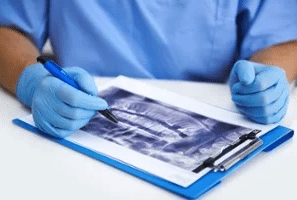 Contemporary implant dentistry has moved into the digital world. CBCTs and intra oral laser scanning have given us the three dimensional tools to accurately plan our patients implants. Unfortunately, the vast majority of dental implants are placed freehand. Freehand placement can lead to poor implant placement. Poor implant placement means you, the restorative dentist, must spend more time optimizing the final prosthetics and in the worst cases perimplantitis and implant failure. We know image guided surgery is the more accurate than freehand. So why not guide every implant? (Somogyi-Ganss, 2013; Tahmased A, Wismeijer D, Coucke W, 2014) In referring your patients to a surgeon, you might want insight on cutting edge options for placement.
Contemporary implant dentistry has moved into the digital world. CBCTs and intra oral laser scanning have given us the three dimensional tools to accurately plan our patients implants. Unfortunately, the vast majority of dental implants are placed freehand. Freehand placement can lead to poor implant placement. Poor implant placement means you, the restorative dentist, must spend more time optimizing the final prosthetics and in the worst cases perimplantitis and implant failure. We know image guided surgery is the more accurate than freehand. So why not guide every implant? (Somogyi-Ganss, 2013; Tahmased A, Wismeijer D, Coucke W, 2014) In referring your patients to a surgeon, you might want insight on cutting edge options for placement.
Today, there are 2 navigation methods available that significantly improve the accuracy of dental implant placements: static guides and dynamic image navigation. Two leading innovators in dental implant surgery, Michael S. Block, DMD, and Robert W. Emery, DDS, share their in-depth analysis of the benefits and limitations of both navigation methods in their report, “Static or Dynamic Navigation for Implant Placement—Choosing the Method of Guidance.”(Block & Emery, 2016)
Not only is accurate placement important for cosmetic reasons, but it helps avoid injury to the patient and improves the success of the implant. Planning ahead ensures that the procedure goes smoothly for the best results.
Both static and dynamic navigation have their benefits and limitations. The choice between placement methods may come down to the specific situation, clinician preference, or level of experience.
Using a Static Guide for Implant Placement
Within the static placement of dental implants, position changes cannot be made during the surgical procedure. Instead, the implant position is determined ahead of time through a computer-aided design and manufacturing that creates stents to guide placement.
With static guidance, the angle of placement varies less than 5 degrees from what was planned. Not only is the accuracy of placement much higher than in freehand placement, but the size of the incisions can be minimized, reducing the risks and discomforts of surgery.
Static systems do require additional time and cost because of the laboratory work required.
Using Dynamic Navigation for Implant Placement
Dynamic navigation uses optical technologies to track the patient and the surgeon’s handpiece, allowing them to be displayed on a monitor. During surgery, tracking arrays are attached to the patient’s arch and the handpiece so they can triangulate with cameras for more accurate navigation. The surgeon uses a navigation screen to guide the drill instead of trying to see the drill inside the patient’s mouth.
Dynamic navigation systems, like the X-Guide, allow the surgeon to use traditional anesthesia and minimally invasive incisions. Unlike static guide placement, dynamic navigation is cost effective and less time consuming. The implant size, system, and location can also be changed during the surgery.
This method of placement does have a learning curve. Developing proficiency may take anywhere from 10 to 20 cases, so you want to ensure your surgeon has that experience.
The Deciding Factor for Dental Implant Placement Methods
Both the static and dynamic placement methods are much more accurate than the freehand method and have similar indications for use. Choosing between the methods may come down to the patient’s condition.
Reading the report by Block and Emery will give you details about each guidance system procedure so you can let your patients know what to expect.
Learn more about these new dental implant placement methods by getting your copy of “Static or Dynamic Navigation for Implant Placement—Choosing the Method of Guidance.”
Block, M. S., & Emery, R. W. (2016). Static or Dynamic Navigation for Implant Placement—Choosing the Method of Guidance. Journal of Oral and Maxillofacial Surgery, 74(2), 269–277. http://doi.org/10.1016/j.joms.2015.09.022
Somogyi-Ganss, E. (2013). Evaluation of the Accuracy of NaviDent, a noval dynamic computer-guided navigation system for placing dental implants. Graduate Department of Prosthodontics.
Tahmased A, Wismeijer D, Coucke W, D. W. (2014). Computer Technology Application in Surgical Implant Dentistry: A systematic Review. Int J Oral Maxillofac Implants, 29(SUPPL), 25–42. http://doi.org/10.11607/jomi.2014suppl.g1.2